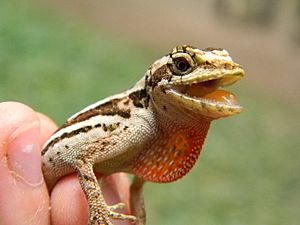Ghost anole facts for kids
Quick facts for kids Ghost anole |
|
|---|---|
 |
|
| Conservation status | |
| Scientific classification | |
| Genus: |
Anolis
|
| Species: |
lemurinus
|
The Anolis lemurinus, also known as the ghost anole, is a type of lizard. It belongs to the family called Dactyloidae. You can find this lizard in many countries across Central and South America. These include Mexico, Guatemala, Belize, El Salvador, Honduras, Nicaragua, Costa Rica, Panama, and Colombia.
Contents
What is a Ghost Anole?
The ghost anole is a small to medium-sized lizard. Like other anoles, it is known for its ability to change color. This helps it blend into its surroundings. They often have shades of brown, gray, or green. This helps them hide from predators and sneak up on their prey.
Where Do Ghost Anoles Live?
Ghost anoles live in warm, tropical areas. They prefer forests and woodlands. You can often spot them on tree trunks, branches, or even on the ground among leaves. They like places with lots of plants where they can find food and shelter. Their wide range shows they can adapt to different forest environments.
What Do Ghost Anoles Eat?
Ghost anoles are insect eaters. Their diet mainly consists of small insects and other tiny creatures. They might eat crickets, spiders, and other small bugs. They are active hunters during the day. They use their excellent eyesight to spot prey. Then, they quickly pounce to catch their meal.
Life and Behavior
Ghost anoles are mostly active during the daytime. They are often seen climbing trees and bushes. They use their special toe pads to grip surfaces. This allows them to move easily on vertical surfaces. They are quite agile and quick.
How Do Anoles Communicate?
Anoles, including the ghost anole, use special ways to communicate. Males often display a colorful throat fan called a "dewlap." They flash this dewlap to attract females. They also use it to warn other males to stay away from their territory. This display is a quick way to show off their strength and health.
Reproduction and Life Cycle
Female ghost anoles lay eggs. They usually lay one or two eggs at a time. The eggs are often hidden in soft soil or under leaf litter. After a period, the baby anoles hatch from the eggs. They are very small when they hatch. They must quickly learn to find food and avoid predators. Anoles grow through several stages. They shed their skin as they get bigger. This process is called molting.
Conservation Status
The ghost anole is listed as "Least Concern" (LC) by the IUCN. This means that its population is currently stable. It is not considered to be in danger of extinction. However, like many animals, their habitats can be threatened by deforestation. Protecting their forest homes is important for their future.


